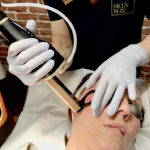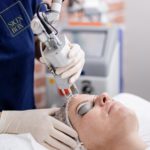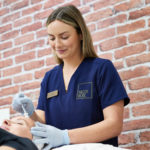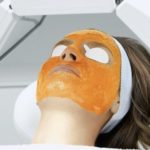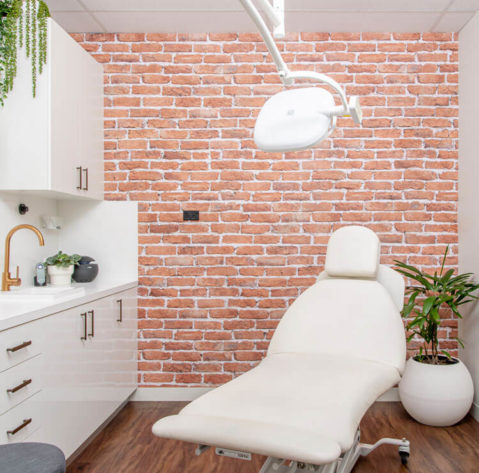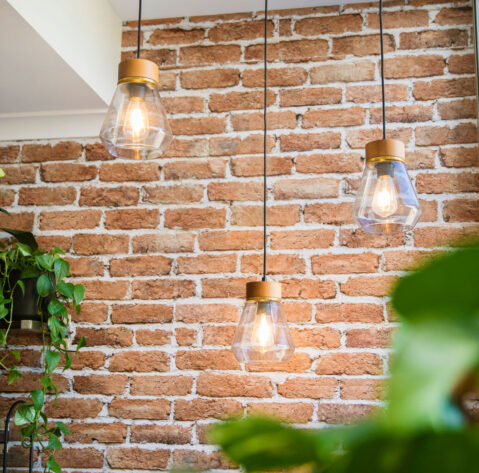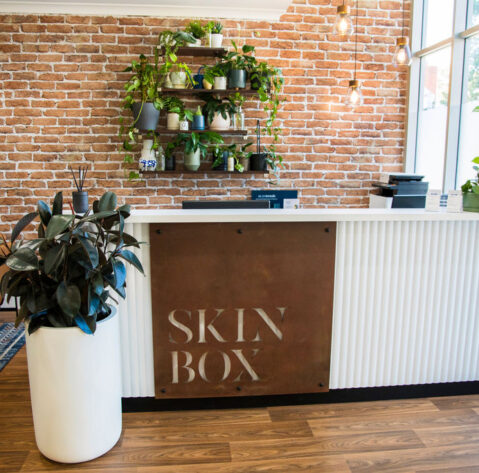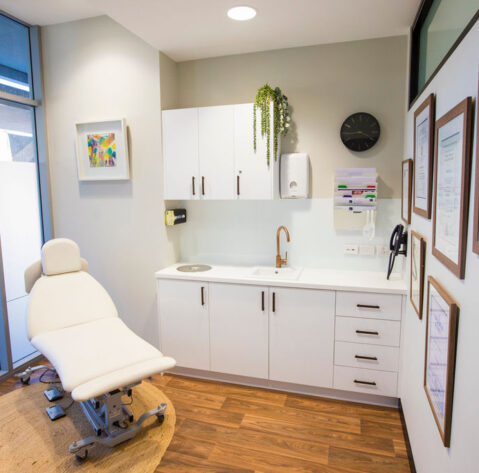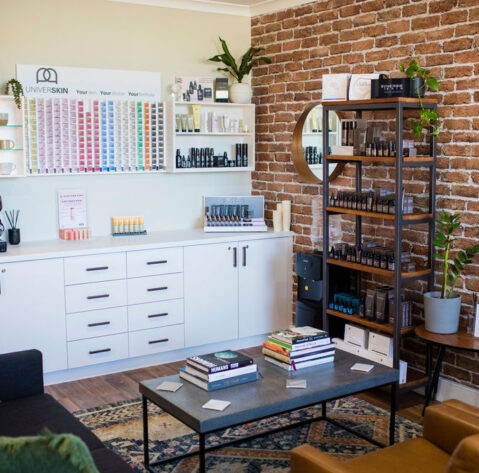PART ONE: Acne and its aftermath – a guide to acne scarring & laser treatments
Acne – to some it is just a pesky chronic skin condition, whilst for others it is major issue that impacts many facets of life. Acne is a real party crasher – it loves to make appearances in the form of all sorts of unwelcome eruptions like open and closed comedones, pustules, papules, and cysts. And talk about unwelcome guests! Acne affects more than 80% of adolescents, 50-60% of women aged 20-25 years, and even 12% of women over 25 (1).
So, what’s behind this skin nightmare? Well, it’s a combination of factors: abnormal keratinization of the pilosebaceous canal (skin overgrowing around the hair follicles), increased sebum (oil) production, bacterial colonization, as well as inflammatory and hormonal disorders of the skin. It’s like a chaotic dance party on your face. There are numerous ways to treat active acne and you are welcome to come in and see us if you need help in this department, but this blog post is about diving specifically into the aftermath of this unruly party.
Acne scars are the battle scars left behind, and they tend to be more prevalent in those who have had a severe case of acne. These scars not only affect the appearance of the skin but can also take a toll on the quality of life. Many patients with acne scarring describe feeling ashamed, embarrassed, and anxious because of those unwanted reminders on their skin. It’s no wonder that people with acne scars often experience social isolation, and in some cases, it can even lead to depression and thoughts of self-harm. It’s a real emotional roller coaster!
When it comes to scars, we need to understand their origins to work out how to tackle them,. A scar is the result of the healing process after any sort of injury, be it chemical, mechanical, or thermal. In the case of acne, scars can form as a complication of skin inflammation. The process of scar formation is a journey that involves three phases: inflammatory, healing, and remodelling. During this journey, the production and degradation of collagen play a crucial role. If something goes haywire in this process, it can lead to various types of scars, which need different sorts of treatment. Let’s break them down!
Acne scars can be classified into three main types: atrophic, hypertrophic, and discoloured. Atrophic scars are those that lie beneath the surface of the skin and create a sunken appearance. On the flip side, hypertrophic scars are raised above the skin’s surface, making their presence known to the world. It’s like they’re shouting, “Look at me!”
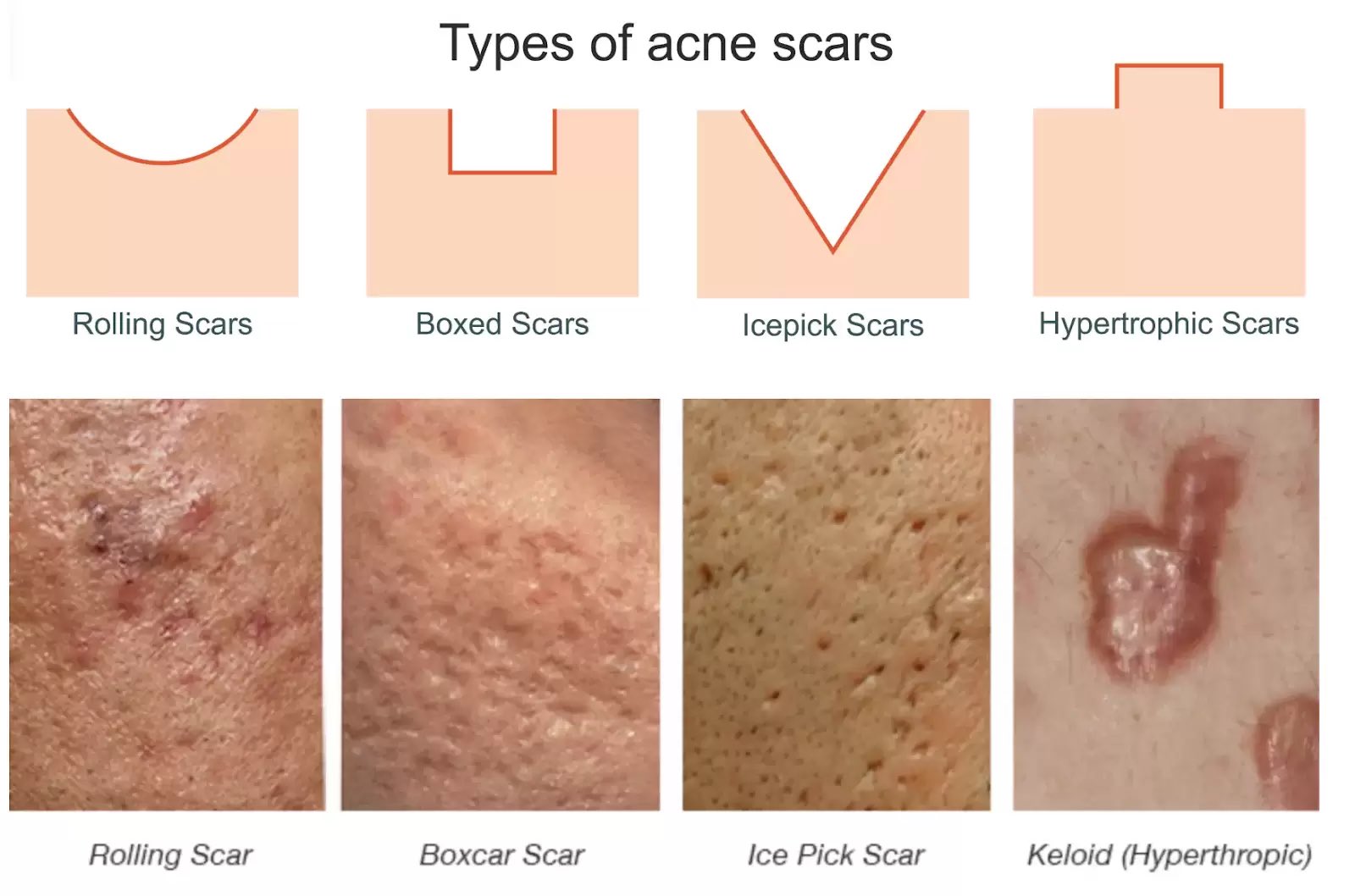
Within the atrophic scars category, there are three subtypes: icepick, rolling, and boxcar. Ice pick scars are the deep, narrow scars that can extend from the border of the dermis to the subcutaneous tissue. They have sharp edges and a V-shaped cross-section, almost like the skin has been pierced with a skewer. These scars account for the majority, around 60-70%, of atrophic scars (1).
Boxcar scars, on the other hand, are oval or round in shape and have a wider and flatter appearance. They resemble the letter U or a square, with well-defined edges. They can range from 0.1 to 0.5 mm in depth and 1.5 to 4 mm in width, and sometimes they even form clusters. About 15-20% of atrophic scars fall into this category (1). They’re like little potholes on your skin!
Rolling scars take the crown for being the largest of the atrophic scars, reaching a diameter of up to 5 mm. They make up around 15-25% of atrophic scars (1). These scars give the skin a wavy or rolling appearance, hence the name. They’re like little hills and valleys, adding some extra texture to your skin.
Now that we’ve explored the different types of acne scars, let’s move on to the exciting part – how can we treat them:
Up for discussion first is the fascinating world of laser acne scar therapy and how it works its magic on your skin. You may have noticed there are many sort of lasers are out there, so how do you pick from this laser wizardry? There are a lot of different options available, and it can be very confusing. To break it down, lasers used to treat acne scarring basically fall into two categories: ablative and non-ablative. There are two key mechanisms at play here that make laser therapy a game-changer for acne scars.
Firstly, some of the lasers (the ablative ones – see below) work their wonders by removing the top layer of your skin through the precise application of heat. Think of it as a gentle heating process that causes the outer layer of your scar to peel away. As a result, your skin looks smoother, and the appearance of the scar becomes less noticeable. It’s like unveiling a fresh canvas!
But that’s not all. The laser’s heat and light have another trick up their sleeves. They actually stimulate the growth of new, healthy skin cells while the scar tissue starts to disintegrate. It’s a dual action process where the laser’s heat draws blood to the area, and this blood flow helps in reducing inflammation by targeting the blood vessels within the scar. It’s like a concentrated effort to calm things down, promote healing and effectively “re-model” the scarring while improving the overall health and function of the skin in that area. This mechanism of action is fundamentally the same with both the ablative and non-ablative lasers. Laser treatment does not remove or erase acne scarring, the aim is to blend the scars in to make them less noticeable and at the same time encourage new, healthier and more functional skin to grow into the scarred area.
Whilst this sounds wonderful, it’s not for everyone – darker skin types can be problematic with laser therapy as they have a tendency to create more pigment when the skin is heated, and also the downtime and effects can vary significantly between patients and between laser devices.
So, let’s look at the ablative lasers first:
Traditional ablative lasers like carbon dioxide (CO2) and pulsed Erbium (Er:YAG) work their magic by burning the skin to a precise depth to create microscopic treatment zones. This stimulates the formation of new collagen and promotes re-epithelialisation. It’s like hitting the refresh button on your skin!
The use of CO2 lasers for acne scar treatment dates back to the 1980s. But since that time, technology has improved immensely, with pulsed action lasers entering the scene, bringing improved precision and depth control, and reducing side effects. We also now have “hybrid” lasers – where more than one type of laser beam can be delivered at the same time (more about that later). These lasers can be either fully ablative, treating the entire surface of the skin, or “fractional,” where only small areas are treated to speed up the recovery process. It’s like a strategic retreat, leaving some troops behind to rebuild faster.
Now, let’s talk results! Studies have shown that fractional CO2 laser treatment, conducted over three sessions, led to better outcomes in reducing atrophic acne scars, as assessed after three months(2). Combining different treatments has also proven to be a game-changer. For instance, a comparison of fractional ablative CO2 laser treatment with skin injections of platelets showed that whilst both treatments are effective on their own – the two together causes the biggest improvement in atrophic scars(3). Teamwork makes the dream work!
Another powerful player in the ablative laser game is the pulsed Er:YAG laser. It’s like a gentler alternative to the traditional CO2 laser, delivering more precise thermal energy to the skin. The Er:YAG laser primarily targets the epidermis and superficial dermis, causing less thermal damage compared to the CO2 laser. It’s a bit like a precision strike, hitting the mark with finesse but not getting as deep.
Just like with CO2 lasers, fractional Erbium treatments are often favoured over fully ablative ones. Studies have shown that fractionated Er:YAG laser treatments outperformed fully ablative Er:YAG treatments in individuals with hypertrophic scars(4). The fractionated approach showed superior outcomes, giving hope to those battling those raised scars.
So, we’ve explored the world of ablative laser resurfacing for acne scars, and now it’s time to dive into another exciting category of laser treatments: non-ablative lasers. These lasers may not be as intense as their ablative counterparts, but they still pack a punch when it comes to reducing acne scars. So, let’s shed some light on these innovative lasers and how they can help you achieve smoother, scar-free skin!
The non-ablative laser family includes the pulsed dye laser (PDL) with a wavelength of 585 to 600 nm, Nd:YAG with a wavelength of 1320 nm, the diode laser with a wavelength of 1450 nm, and the non-ablative Erbium glass laser around 1540-70nm. These lasers are particularly effective in tackling scars classified as boxcar or atrophic, helping to diminish their appearance. It’s like waving a magic wand to fade those scars away!
One remarkable member of this laser family is the pulsed dye laser (PDL). The PDL targets haemoglobin, a pigment in the blood vessels, and works its magic by simultaneously reducing scars of various origins while eliminating blood vessels within the scar tissue. However, it’s important to note that a potential side effect of using this device is persistent post-operative purpura, a purple discolouration that can last for up to 14 days(1). But hey, beauty sometimes comes at a temporary cost!
Now, let’s talk results! A study conducted by Rogachefsky et al. explored the effectiveness of a 1320-nm Nd:YAG laser in treating atrophic or mixed pattern scarring. Twelve patients underwent three laser sessions, and the results were impressive(5). Physicians noted a mean improvement of 1.5 points on a scale of acne scars (p = 0.002), while patients reported an even more significant improvement of 2.2 points (p = 0.01). And the cherry on top? No complications were reported after six months. Now that’s something to celebrate!
But that’s not all. Sadick et al. examined the efficacy of a 1320nm Nd:YAG laser in treating acne scars. Eight participants with acne scars received six monthly treatments with this laser, and significant scar improvement was observed(6). Another study by Tanzi et al. compared the 1320nm Nd:YAG laser with a 1450nm diode laser. Twenty patients with mild-to-moderate atrophic acne scars underwent three monthly treatments, with the 1450nm diode laser demonstrating a better clinical response(7). It’s like a friendly competition among lasers to give you the best results!
The 1450-nm diode laser also took the spotlight in a study by Rathod et al. involving 48 participants with acne scars. After five treatment sessions using a low-energy double-pass technique, a whopping 92.9% of the patients showed more than 30% improvement in their acne scarring by the third month(8). Talk about a laser-powered transformation! Five sessions is quite a lot but with minimal downtime for each one, this approach may be better suited to some lifestyles.
Another non-ablative player making waves in the world of acne scarring is the 1540nm fractional Erbium glass laser. Not to be confused with the Er:YAG, the glass laser doesn’t make holes through the skin from the top, it just makes little explosive bursts within the dermis, kick-starting a wound healing process that targets those rolling and boxcar scars. In a head to head study with fractional ablative CO2, the non-ablative erbium was not quite as effective as the fractional ablative CO2 for treating mild-moderate acne scarring, but offered less pain and shorter downtime(9).
These non-ablative laser treatments offer a safe and efficient way to improve atrophic acne scarring with less downtime and more treatments needed than with the ablative lasers. Hmmm, so why not have both? Well actually, you can. Hybrid devices are the newest generation of lasers, combining both fractional ablative and non-ablative wavelengths to give the best of both worlds – efficacy with reduced downtime. Win-win. Ooh, and they are great for darker skin types that might not be suitable for the traditional ablative lasers.
Let’s get to the real-life stuff: cost, pain & downtime:
Cost: According to the American Society of Plastic Surgeons, the average price for laser skin resurfacing is around $2,000 for ablative and $1,100 for non-ablative laser treatments, assuming the entire face is treated. The cost of laser treatment for acne scarring will depend on several factors, including:
- the number & type of scars you’re treating
- the size of the area being targeted for treatment
- the number of treatments you’ll need
- the experience level of your provider
- what combination of different treatments are required for your particular acne scarring – more than one type of laser may be needed and other synergistic options may be done at the same time (eg TCA-CROSS, subcision or injectables – we’ll discuss these in our next blog post)
Pain: Discomfort during laser resurfacing depends upon the type of laser, the depth and intensity of the beam and also your own pain threshold. The following types of pain relief are commonly used:
- topical anaesthetic ointment or cream
- facial nerve blocks (local anaesthetic is injected around a nerve, similar to having dental work done)
- tumescent local anaesthesia (anaesthetic is injected just underneath the skin – this helps stretch the skin out and is particularly useful when boxcar scarring is being treated)
- cold-air cooling
- built-in chiller plates in the laser device (where the part touching your skin is cold)
Many of the non-ablative laser treatments are so comfortable that some people can tolerate them with no pain relief at all.
Downtime: The downtime from laser treatment varies depending upon the type of laser being used. The intensity of the settings, your baseline skin condition and your age can also impact the recovery period. Generally, the non-ablative lasers have a quicker recovery time as they don’t break the skin, so you can use makeup sooner (still a good idea to go for a medical-grade foundation on freshly lasered skin though) and you should expect to be able to carry on your normal activities with just a bit of redness and dryness that lasts a few days. The traditional fully ablative lasers would give a downtime of around 2 weeks, with the fractional versions reducing this to about 1 week. The newer Hybrid lasers that use a combo of ablative and non-ablative drop the downtime even further to around 3-5 days and you may be able to get back work after just a day or two with your medical-grade foundation on.
Please note – when we say downtime we are talking about the length of time for your skin to stop looking scabby and swollen, not the length of time to see the final results. With the ablative lasers that cause scabs, there is an immediate improvement once the scabs come off, but the end result takes 3-6 months. Remember, we are waiting for your skin to make new collagen and that takes time.
So, there you have it, folks! A glimpse into the world of ablative and non-ablative laser resurfacing for acne scars. With advancements in technology and a combination of treatments, we can bid farewell to the annoying reminders of our skin’s past struggles.
Remember, always consult with a Dermatologist, Aesthetic Doctor or Dermal Therapist to determine the best treatment plan for your unique skin needs.
References:
- Chilicka, K., Rusztowicz, M., Szyguła, R., & Nowicka, D. (2022). Methods for the Improvement of Acne Scars Used in Dermatology and Cosmetology: A Review. Journal of clinical medicine, 11(10), 2744. https://doi.org/10.3390/jcm11102744
- Fang, F., Yang, H., Liu, X., Ding, H., Yang, Y., Ge, Y., & Lin, T. (2022). Treatment of acne scars with fractional carbon dioxide laser in Asians: a retrospective study to search for predicting factors associated with efficacy. Lasers in medical science, 37(6), 2623–2627. https://doi.org/10.1007/s10103-022-03528-w
- Galal, O., Tawfik, A. A., Abdalla, N., & Soliman, M. (2019). Fractional CO2 laser versus combined platelet-rich plasma and fractional CO2 laser in treatment of acne scars: Image analysis system evaluation. Journal of cosmetic dermatology, 18(6), 1665–1671. https://doi.org/10.1111/jocd.12909
- Tidwell, W. J., Owen, C. E., Kulp-Shorten, C., Maity, A., McCall, M., & Brown, T. S. (2016). Fractionated Er:YAG laser versus fully ablative Er:YAG laser for scar revision: Results of a split scar, double blinded, prospective trial. Lasers in surgery and medicine, 48(9), 837–843. https://doi.org/10.1002/lsm.22562
- Rogachefsky, A. S., Hussain, M., & Goldberg, D. J. (2003). Atrophic and a mixed pattern of acne scars improved with a 1320-nm Nd:YAG laser. Dermatologic surgery : official publication for American Society for Dermatologic Surgery [et al.], 29(9), 904–908. https://doi.org/10.1046/j.1524-4725.2003.29256.x
- Sadick, N. S., & Schecter, A. K. (2004). A preliminary study of utilization of the 1320-nm Nd:YAG laser for the treatment of acne scarring. Dermatologic surgery : official publication for American Society for Dermatologic Surgery [et al.], 30(7), 995–1000. https://doi.org/10.1111/j.1524-4725.2004.30304.x
- Tanzi, E. L., & Alster, T. S. (2004). Comparison of a 1450-nm diode laser and a 1320-nm Nd:YAG laser in the treatment of atrophic facial scars: a prospective clinical and histologic study. Dermatologic surgery : official publication for American Society for Dermatologic Surgery [et al.], 30(2 Pt 1), 152–157. https://doi.org/10.1111/j.1524-4725.2004.30078.x
- Rathod, D., Foroughi, A., Mekokishvili, L., Wollina, U., Lotti, T., Rajan, A., & Goldust, M. (2020). A cross-sectional, multi-center study on treatment of facial acne scars with low-energy double-pass 1450-nm diode laser. Dermatologic therapy, 33(3), e13326. https://doi.org/10.1111/dth.13326
- Elsaie, M. L., Ibrahim, S. M., & Saudi, W. (2018). Ablative Fractional 10 600 nm Carbon Dioxide Laser Versus Non-ablative Fractional 1540 nm Erbium-Glass Laser in Egyptian Post-acne Scar patients. Journal of lasers in medical sciences, 9(1), 32–35. https://doi.org/10.15171/jlms.2018.08

